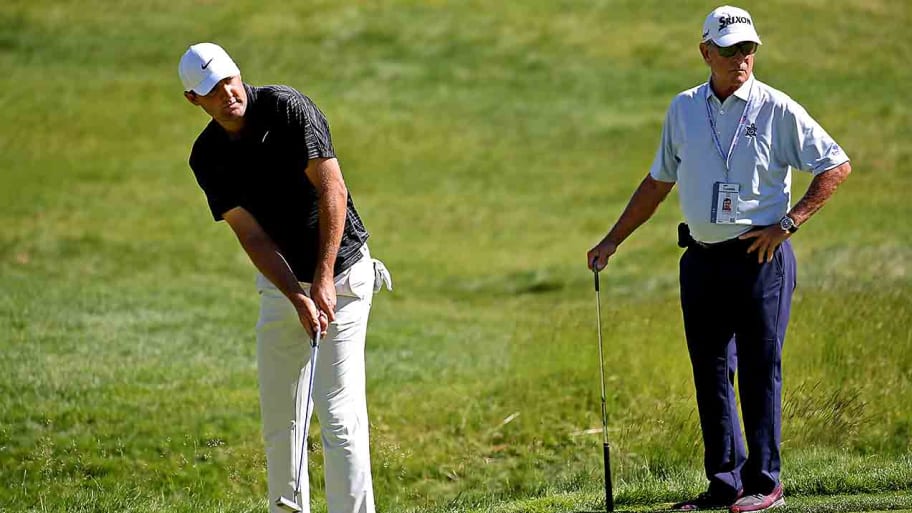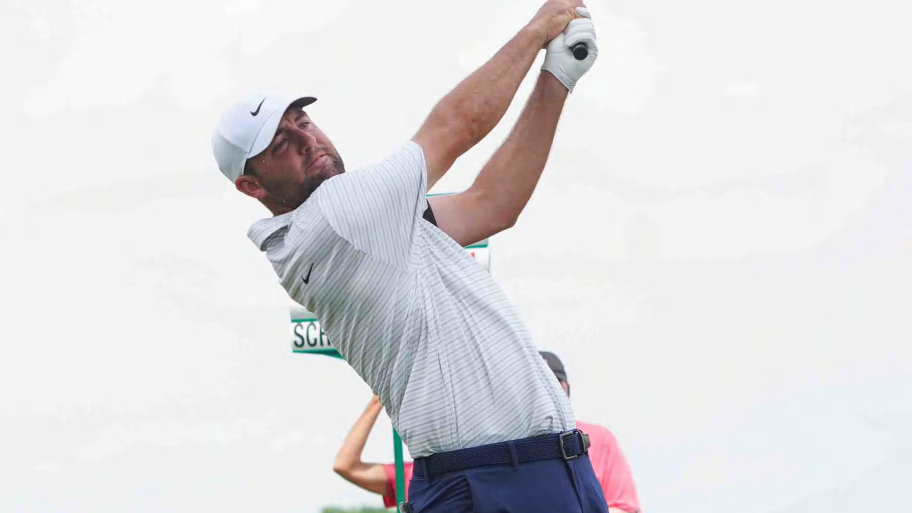
TROON, Scotland – The Scottie Scheffler shuffle is such that the purists are prone to wince. It’s something you’d never teach, and if he were someone well below the status of the best golfer in the world, the instinct would understandably be to seek changes.
Golfers have been told forever that feet quiet are imperative for a solid, repeatable golf swing. Sure, there will be movement, like the back foot coming off the ground during the follow through or other variations.
But Scheffler’s foot dance always appears as if he slipped on a banana peel.
And yet his shots pierce through the air, and his statistics for nearly every full-swing category that exist hover near the top of the PGA Tour list.
Those feet might move a good bit, but they’ve also been kicking everyone else in golf for the better part of two years.
“A lot of it has to do with how much he grew,’’ says Scheffler’s longtime coach, Randy Smith. “He got so big and strong, 6-foot-3. Long arms. He’s nothing but an athlete. He can dribble, shoot 3s, world-class pickle ball player and don’t play him in ping pong. He plays golf like an athlete and he has phenomenal feel with his hands and great players feel where the clubface is.
“When you are aware of that, you can do all sorts of things with the golf ball and with confidence. The bigger and stronger he got, the more his feet started to move with that. But rather than change that so it’ll look pretty, I felt comfortable with what he was doing.’’

Scheffler, 28, heads into this week’s British Open at Royal Troon as a prohibitive favorite, with apologies to Xander Schauffele and Bryson DeChambeau, the year’s other major winners.
He finally had a poor week at Pinehurst No. 2, where he tied for 41st while DeChambeau captured his second U.S. Open. But he bounced right back with another victory, winning the Travelers Championship a week later in a playoff over Tom Kim, his sixth win of the year and more than any player at that point of a season since Arnold Palmer in 1962.
“When he’s hitting some of those low burner cuts and you see that right foot come back behind it, that ball is not going to go left,’’ says Smith, 72, who has worked with Scheffler since the golfer was 7 years old. “He’s usually leading the field in driving and he’s kind of eliminated that left miss that has plagued a lot of great players. He just happens to be a much better athlete. It’s just turning on a lot more octane.’’
Other players throughout the game’s history have swung at the ball with the same type of sliding movement, including the likes of major champions Billy Casper, Greg Norman and Mark Calcavecchia.
Calcavecchia, who won his lone major at Royal Troon in 1989 in a playoff over Norman, went to Twitter recently to mock himself for trying to swing the club more like Scheffler does now.
“I tried my old swing. AKA (also known as) the Scottie Scheffler swing,’’ Calcavecchia, now 64, wrote. “Just discovered you need clubhead speed for that. So that idea bit the dust in a hurry.’’
It’s not for everyone, certainly.
For example, Jon Rahm. The two-time major winner plants his right foot and it barely comes off the ground during his follow-through.
“I feel like so much of my stability of my swing comes from that rear foot, and I'm almost the opposite for most of my career, that rear foot being planted for so long, that I don't think I would be a very efficient golfer if I did that,’’ Rahm says. “I don't think I'd be a pro whatsoever. Could I hit it? Possibly, but it wouldn't be pretty.’’
Scheffler’s feet move considerably. They move back behind him as he swings. Sometimes they shift toward the target. This happens on most tee shots, especially when he swings hard. It also occurs on longer iron shots. The movement is not as pronounced with shorter clubs.
“I don’t really know exactly what it does for my clubhead speed,’’ Scheffler says. “I’ve tried to hit a few shots with my irons with what you would call traditional footwork, and I just felt kind of locked in, felt a little bit too robotic.
“I’ve always been a guy who loved hitting a lot of different shots ... changing the height, changing the curve. That’s how I play most of the time. In terms of my footwork, I just felt too kind of locked in and unnatural if I don’t do what my feet normally do. It may look funny to you all, but it feels totally normal to me. I never thought twice about it.’’

Why would he? It works. Scheffler’s now won 12 times over the past three seasons, has a firm grasp on the No. 1 spot in the Official World Golf Ranking, leads the PGA Tour’s FedEx Cup points by a mile and is atop numerous statistical categories.
He’s first in strokes gained total, third in strokes gained off the tee and first in strokes gained approach to the green.
“I probably have not studied his swing enough to understand how it really works, but it seems to me that a lot of that movement happens after that clubface has made contact with the ball,’’ Rahm says. “So whatever happens after doesn’t matter. Once that ball’s flying, it doesn’t matter.
“It seems to be what helps him keep the club face square. It’s that simple Do your own swing, whatever seems repetitive. He clearly can repeat it very well and under pressure.
Scheffler is 89th in strokes gained putting, which is a big improvement over last year and one of the reasons he’s won so often this year. Prior to the Arnold Palmer Invitational, Scheffler went with a mallet style putter and immediately saw success..
He won four of his next five tournaments and finished second in the other. Two more victories have followed, and who knows what might have happened had there not been the issue at the PGA Championship that saw Scheffler land in a Louisville jail cell due to a traffic incident that was later dismissed.
Scheffler rebounded to tie for eighth at Valhalla, and the U.S. Open result last month was his worst in 18 months.

“From my perspective, he’s got full control of his golf swing,’’ said U.S. Open champion Bryson DeChambeau. “He’s figured out a lot of his putting. From what I can tell, he plays some incredibly strategic golf. He doesn’t go too crazy. He just hits the right shots at the right time. He’s really in control of the environment, not only his environment but the conditions on the golf course.’’
A good bit of credit goes to Smith, the Dallas-area teaching pro who didn’t try to force Scheffler to swing in a traditional manner. Scheffler tells a story about being at the Masters one year when former CBS analyst and six-time major winner Nick Faldo approached him on the range.
“He was pretty critical of it at the time,’’ says Scheffler, who then attempted to hit a few “normal’’ shots and immediately knew that it wasn’t for him.
“We have definitely made changes to my swing, but that was something that he never changed,’’ Scheffler says. “I think the words he would use is that was kind of just the DNA of my swing and he doesn’t want to change what I did to try to work the ball.
“I think that was one of the things he liked about me when I was a kid was there was always a pole out on the driving range and I would try to hit it with a straight shot and I’d try to hit it with a draw. I loved being able to try to curve the ball.’’
For all of Scheffler's success, this will be just his fourth appearance in the Open. He tied for eighth three years ago at Royal St. George’s before he had even won a tournament. He finished just outside the top 20 in each of the past two years.
Scheffler’s issues are more about learning to play links golf and getting acclimated to the different conditions than they are about his feet moving all over the place.
Lately he’s trampled enough names in the game to make that clear.
This article was originally published on www.si.com as Scottie's World: With a Swing All His Own, Scheffler Chases More History at British Open.







